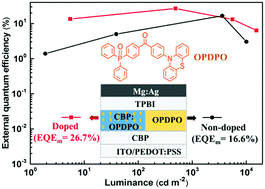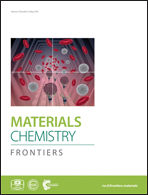An efficient yellow thermally activated delayed fluorescence emitter with universal applications in both doped and non-doped organic light-emitting diodes†
Abstract
Thermally activated delayed fluorescence (TADF) emitters have aroused serious attention for their use in organic light-emitting diodes (OLEDs). However, TADF emitters providing both doped and non-doped OLEDs with high device performance are rare. In this work, we present a yellow TADF emitter (OPDPO) meeting the above requirements. The OPDPO-based doped OLEDs show a maximum external quantum efficiency (EQE) of 26.7%, which is amongst the highest ever reported for doped yellow TADF-based OLEDs. The EQE remains as high as 22.1% at a luminance of 1000 cd m−2. Meanwhile, the OPDPO-based non-doped OLEDs afford a maximum EQE of 16.6% at a high luminance of 3600 cd m−2, which is amongst the best performances of non-doped yellow TADF-based OLEDs. Moreover, simple and efficient white OLEDs are implemented by combining a blue conventional fluorescent emitter with either a doped or non-doped OPDPO emissive layer, confirming the universal applications of OPDPO in high-performance OLEDs.



 Please wait while we load your content...
Please wait while we load your content...